Mechanical Ventilation Strategies in Buildings: A Comprehensive Review of Climate Management, Indoor Air Quality, and Energy Efficiency
Abstract
1. Introduction
2. Review Method
2.1. Studies Related to Ventilation Rate Measurement and Control
2.2. Studies Related to Indoor Air Quality and Health
2.3. Studies Related to Energy Efficiency and Heat Recovery
2.4. Studies Related to Thermal Comfort and Hybrid Systems
2.5. Studies Related to CFD and Numerical Modelling
3. Critical Analysis of Mechanical Ventilation in Buildings
4. Conclusions
- DCV systems, when integrated with real-time monitoring, can reduce energy usage by up to 88% by modulating airflow based on occupancy and indoor air quality.
- Hybrid systems yielded predicted mean vote (PMV) values from –0.41 to +0.37, representing satisfactory thermal comfort under radiant heating.
- Effective operation of DCV systems depends critically on sensor accuracy, proper calibration, and regular maintenance; without these, the systems may lead to increased energy consumption and compromised air quality.
- Mechanical ventilation can reduce indoor CO2 concentrations by approximately 30% and also lower levels of pollutants such as PM2.5 and VOCs.
- Occupant behaviour significantly affects performance. When users override or disable mechanical systems, indoor CO2 concentrations may exceed recommended thresholds, undermining ventilation effectiveness.
- Heat recovery ventilation systems demonstrate efficiencies of up to 90%, reducing heating demand by approximately 19% in cold climate conditions.
- Hybrid systems that combine mechanical and natural ventilation can improve thermal comfort but are less effective in areas with high outdoor air pollution.
- User satisfaction is negatively influenced by noise, perceived dryness, and limited control over system operation. Notably, 35 out of 46 occupants surveyed reported not understanding how to operate their ventilation systems.
- Localized ventilation improves comfort in occupied zones but requires tailored airflow design to minimize drafts and prevent excessive mixing.
- CFD modelling and smart ventilation algorithms offer precise airflow management but are often cost-prohibitive, complex, and difficult to scale in existing buildings.
- Further development is needed to address challenges related to fire safety, condensation control, and the durability of components such as filters and heat exchangers.
5. Further Enhancements and Accompanying Challenges
- Integration of artificial intelligence (AI), Internet of Things (IoT), and machine learning is essential to optimise ventilation by adapting in real time to occupancy levels, outdoor air quality, and energy usage.
- Development of predictive algorithms that can forecast ventilation demand by incorporating weather forecasts and historical usage patterns.
- Implementation of hybrid strategies that combine natural, mechanical, and mixed-mode ventilation systems to ensure both energy efficiency and indoor air quality across different climatic conditions.
- Incorporation of backup power systems and passive ventilation strategies to ensure continuous operation during energy outages, particularly for critical infrastructure such as data centres.
- Innovation in heat exchanger materials and designs that increase performance while minimising maintenance requirements.
- Exploration of PCMs and thermoelectric systems to enhance thermal regulation capabilities.
- Development of personalized ventilation controls that allow occupants to adjust airflow without compromising the system’s overall energy performance.
- Design of user-friendly interfaces that provide real-time feedback on system status and performance, supporting timely maintenance and informed user interaction.
- Integration of renewable energy sources, such as solar, wind, or geothermal systems, to reduce reliance on grid electricity for ventilation.
- Use of energy storage systems, such as batteries or thermal storage, to manage peak energy loads and ensure stable operation.
- Formulation of unified ventilation standards applicable across various building types and climate zones.
- Proposal of policy incentives to encourage the retrofit of older buildings with energy-efficient ventilation technologies.
- High initial costs associated with smart control technologies, heat recovery systems, and renewable integration deter adoption, especially in developing regions.
- Ongoing maintenance expenses, such as filter replacements and routine servicing, contribute to long-term operating costs.
- Performance limitations in hot, humid, or heavily polluted environments reduce the efficiency of some systems.
- Lack of localized guidelines results in suboptimal strategies for tropical, arid, or polar climate zones.
- Occupant resistance to automated controls, due to perceived noise, reduced autonomy, or discomfort, can limit system use.
- Low user engagement may lead to improper operation, system overrides, or neglect, negating potential benefits.
- Sensor inaccuracies, particularly for CO2 and humidity, can result in incorrect ventilation rates, wasting energy or compromising air quality.
- The complexity of CFD and AI-based models often restricts their implementation to specialists, limiting scalability.
- Condensation, moisture, and mould issues may arise in warm climates if airflow is insufficient.
- Fire safety concerns increase in buildings with extensive mechanical infrastructure, particularly during emergencies.
- Inconsistent building codes and inspection standards across regions create regulatory and compliance barriers.
- Limited public understanding of ventilation’s health and energy benefits can reduce interest in adopting modern systems.
Author Contributions
Funding
Data Availability Statement
Conflicts of Interest
Abbreviations
| ACH | Air Changes per Hour (h−1) |
| AMX | Active Membrane Energy Exchanger |
| CAV | Constant Air Volume |
| CFD | Computational Fluid Dynamics |
| CH | Ceiling Heating |
| CMV | Controlled Mechanical Ventilation |
| CO2 | Carbon Dioxide |
| CRE | Contaminant Removal Effectiveness |
| DALY | Disability-Adjusted Life Year |
| DCV | Demand-Controlled Ventilation |
| DLV | Dilution Ventilation |
| DMV | Demand-Controlled Mechanical Ventilation |
| DR | Draught Rate |
| DV | Displacement Ventilation |
| EAHP | Exhaust Air Heat Pumps |
| EEH | Energy-Efficient Home |
| ESP | Energy-Saving Performance |
| FH | Floor Heating |
| GLMM | Generalized Linear Mixed Model |
| HRV | Heat Recovery Ventilation |
| IAQ | Indoor Air Quality |
| MBCS | Mechanical Board-Coupled Shaft |
| MEV | Mechanical Ventilation |
| MLE | Maximum Likelihood Estimation |
| MVHR | Mechanical Ventilation with Heat Recovery |
| NPV | Net Present Value |
| NV | Natural Ventilation |
| OCC | Occupant-Centric Control |
| PCM | Phase-Change Material |
| PMV | Predicted Mean Vote |
| PPD | Predicted Percentage Dissatisfied |
| PM2.5 | Particulate Matter ≤2.5 µm |
| R2 | Coefficient of determination |
| RH | Relative Humidity |
| TDV | Time-Dependent Valuation |
| TSC | Transpired Solar Collector |
| VAV | Variable Air Volume |
| VC | Ventilative Cooling |
| VOC | Volatile Organic Compound |
| WHMV | Whole-House Mechanical Ventilation |
References
- Prüss-Üstün, A.; Wolf, J.; Corvalán, C.F.; Bos, R.; Neira, M.P. Preventing Disease Through Healthy Environments: A Global Assessment of the Burden of Disease from Environmental Risks; World Health Organization: Geneva, Switzerland, 2016; Available online: https://iris.who.int/handle/10665/204585 (accessed on 22 January 2025).
- World Health Organization, Regional Office for Europe. WHO Guidelines for Indoor Air Quality: Dampness and Mould; WHO Europe: Copenhagen, Denmark, 2009. [Google Scholar]
- Ding, E.; Zhang, D.; Bluyssen, P.M. Ventilation regimes of school classrooms against airborne transmission of infectious respiratory droplets: A review. Build. Environ. 2022, 207, 108484. [Google Scholar] [CrossRef]
- Abuhegazy, M.; Talaat, K.; Anderoglu, O.; Poroseva, S.V. Numerical investigation of aerosol transport in a classroom with relevance to COVID-19. Phys. Fluids 2020, 32, 103311. [Google Scholar] [CrossRef]
- Li, H.; Zhong, K.; Zhai, Z. Investigating the influences of ventilation on the fate of particles generated by patient and medical staff in operating room. Build. Environ. 2020, 180, 107038. [Google Scholar] [CrossRef]
- United Nations Environment Programme, Global Alliance for Buildings and Construction. 2020 Global Status Report for Buildings and Construction: Towards a Zero-Emissions, Efficient and Resilient Buildings and Construction Sector—Executive Summary; United Nations Environment Programme, Global Alliance for Buildings and Construction: Paris, France, 2020; Available online: https://wedocs.unep.org/20.500.11822/34572 (accessed on 24 January 2025).
- Energiewende, A. Die Energiewende in Deutschland: Stand der Dinge 2021: Rückblick auf die Wesentlichen Entwicklungen Sowie Ausblick auf 2022; Agora Energiewende: Berlin, Germany, 2022. [Google Scholar]
- Aydin, E.; Kok, N.; Brounen, D. Energy efficiency and household behavior: The rebound effect in the residential sector. Rand J. Econ. 2017, 48, 749–782. [Google Scholar] [CrossRef]
- Mysen, M.; Berntsen, S.; Nafstad, P.; Schild, P.G. Occupancy density and benefits of demand-controlled ventilation in Norwegian primary schools. Energy Build. 2005, 37, 1234–1240. [Google Scholar] [CrossRef]
- Olgyay, V.; Olgyay, A.; Lyndon, D.; Olgyay, V.W.; Reynolds, J.; Yeang, K. Design with Climate: Bioclimatic Approach to Architectural Regionalism; New and Expanded Edition; Princeton University Press: Princeton, NJ, USA, 2015. [Google Scholar]
- Heiselberg, P. IEA EBC Annex 62—Ventilative Cooling Design Guide; Aalborg University: Aalborg, Denmark, 2018. [Google Scholar]
- Chiesa, G. (Ed.) Bioclimatic Approaches in Urban and Building Design; Springer International Publishing: Cham, Switzerland, 2021. [Google Scholar] [CrossRef]
- Rashid, F.L.; Al-Obaidi, M.A.; Hatem, W.A.; Al Maimuri, N.M.; Ameen, A.; Ahmad, S.; Agyekum, E.B.; Kadhim, S.A.; Hammoodi, K.A. Optimising phase change materials for ventilated building components in sustainable building design: A comprehensive review. Energy Build. 2025, 343, 115947. [Google Scholar] [CrossRef]
- Persily, A. Challenges in developing ventilation and indoor air quality standards: The story of ASHRAE Standard 62. Build. Environ. 2015, 91, 61–69. [Google Scholar] [CrossRef]
- Griffiths, M.; Eftekhari, M. Control of CO2 in a naturally ventilated classroom. Energy Build 2008, 40, 556–560. [Google Scholar] [CrossRef]
- Costanzo, S.; Cusumano, A.; Giaconia, C. Ventilation rates and unsatisfied percentage from indoor CO2 concentration. Indoor Built Environ. 2011, 20, 232–245. [Google Scholar] [CrossRef]
- World Health Organization. WHO Global Air Quality Guidelines: Particulate Matter (PM2.5 and PM10), Ozone, Nitrogen Dioxide, Sulfur Dioxide and Carbon Monoxide. 2021. Available online: https://www.who.int/publications/i/item/9789240034228 (accessed on 28 January 2025).
- Gaihre, S.; Semple, S.; Miller, J.; Fielding, S.; Turner, S. Classroom carbon dioxide concentration, school attendance, and educational attainment. J. Sch. Health 2014, 84, 569–574. [Google Scholar] [CrossRef]
- Baborska-Narozny, M.; Stevenson, F. Mechanical ventilation in housing: Understanding in-use issues. Proc. Inst. Civ. Eng.-Eng. Sustain. 2017, 170, 33–46. [Google Scholar] [CrossRef]
- Cali, D.; Andersen, R.K.; Osterhage, T.; Wessling, M.; Müller, D.; Olesen, B.W. Analysis of the occupant’s behavior related to natural ventilation. In Proceedings of the 12th REHVA World Congress, Aalborg, Denmark, 22–25 May 2016. [Google Scholar]
- Lai, D.; Qi, Y.; Liu, J.; Dai, X.; Zhao, L.; Wei, S. Ventilation behavior in residential buildings with mechanical ventilation systems across different climate zones in China. Build. Environ. 2018, 143, 679–690. [Google Scholar] [CrossRef]
- Maier, D. Aufbau und Durchführung einer Mixed-Methods-Studie zu Lüftungsverhalten und Raumklima sowie der Einstellung bezüglich Lüftungssystemen: Development and Application of a Mixed-Methods-Survey About Ventilation Behavior and Room Climate as Well as Attitude Towards Ventilation Systems. Master’s Thesis, Catholic University of Eichstätt-Ingolstadt, Freiburg, Germany, 2020. [Google Scholar]
- Kanama, N.; Ondarts, M.; Guyot, G.; Outin, J.; Golly, B.; Gonze, E. Effect of energy renovation on indoor air quality and thermal environment in winter of a primary school in a highly polluted French alpine valley. J. Build. Eng. 2023, 72, 106529. [Google Scholar] [CrossRef]
- Du, B.; Reda, I.; Licina, D.; Kapsis, C.; Qi, D.; Candanedo, J.A.; Li, T. Estimating air change rate in mechanically ventilated classrooms using a single CO2 sensor and automated data segmentation. Environ. Sci. Technol. 2024, 58, 18788–18799. [Google Scholar] [CrossRef] [PubMed]
- Nowak-Dzieszko, K.; Mijakowski, M.; Müller, J. Simulating the natural seasonal ventilation of a classroom in Poland based on measurements of the CO2 concentration. Energies 2024, 17, 4591. [Google Scholar] [CrossRef]
- Calvet, S.; Cambra-López, M.; Blanes-Vidal, V.; Estellés, F.; Torres, A.G. Ventilation rates in mechanically-ventilated commercial poultry buildings in Southern Europe: Measurement system development and uncertainty analysis. Biosyst. Eng. 2010, 106, 423–432. [Google Scholar] [CrossRef]
- Lu, T.; Knuutila, A.; Viljanen, M.; Lu, X. A novel methodology for estimating space air change rates and occupant CO2 generation rates from measurements in mechanically-ventilated buildings. Build. Environ. 2010, 45, 1161–1172. [Google Scholar] [CrossRef]
- Turner, W.J.N.; Logue, J.M.; Wray, C.P. A combined energy and IAQ assessment of the potential value of commissioning residential mechanical ventilation systems. Build. Environ. 2013, 60, 194–201. [Google Scholar] [CrossRef]
- CEC. Title 24, Part 6, California Code of Regulations: California’s Energy Efficiency Standards for Residential and Nonresidential Buildings. Part 6. California Energy Commission. 2008. Available online: https://www.diamondbarca.gov/DocumentCenter/View/91/2008-Energy-Efficiency-Standards-Guide-PDF (accessed on 25 March 2025).
- ANSI/ASHRAE Standard 62.2-2016; Ventilation and Acceptable Indoor Air Quality in Low-Rise Residential Buildings. American Society of Heating, Ventilating, and Air Conditioning Engineers: Atlanta, GA, USA, 2016.
- Shi, Y.; Li, X. A study on variation laws of infiltration rate with mechanical ventilation rate in a room. Build. Environ. 2018, 143, 269–279. [Google Scholar] [CrossRef]
- Shi, Y.; Li, X. Effect of mechanical ventilation on infiltration rate under stack effect in buildings with multilayer windows. Build. Environ. 2020, 170, 106594. [Google Scholar] [CrossRef]
- Zhang, S.; Ai, Z.; Lin, Z. Novel demand-controlled optimization of constant-air-volume mechanical ventilation for indoor air quality, durability and energy saving. Appl. Energy 2021, 293, 116954. [Google Scholar] [CrossRef]
- Shin, H.; Kwak, Y.; Jo, S.-K.; Kim, S.-H.; Huh, J.-H. Development of an optimal mechanical ventilation system control strategy based on weather forecasting data for outdoor air cooling in livestock housing. Energy 2023, 268, 126649. [Google Scholar] [CrossRef]
- Chiesa, G.; Vigliotti, M. Comparing mechanical ventilation control strategies for indoor air quality: Monitoring and simulation results of a school building in northern Italy. Energy Build. 2024, 322, 114665. [Google Scholar] [CrossRef]
- Rizzo, K.; Camilleri, M.; Gatt, D.; Yousif, C. Optimising Mechanical Ventilation for Indoor Air Quality and Thermal Comfort in a Mediterranean School Building. Sustainability 2024, 16, 766. [Google Scholar] [CrossRef]
- Liu, Y.; Dang, R.; Yang, B.; Liu, P. Energy-efficient control strategy for air conditioning and mechanical ventilation system based on occupant distribution -A case study on stratum ventilation. J. Build. Eng. 2025, 100, 111709. [Google Scholar] [CrossRef]
- Paul, T.; Sree, D.; Aglan, H. Effect of mechanically induced ventilation on the indoor air quality of building envelopes. Energy Build. 2010, 42, 326–332. [Google Scholar] [CrossRef]
- Yu, C.K.H.; Li, M.; Chan, V.; Lai, A.C.K. Influence of mechanical ventilation system on indoor carbon dioxide and particulate matter concentration. Build. Environ. 2014, 76, 73–80. [Google Scholar] [CrossRef] [PubMed]
- Kamendere, E.; Zogla, G.; Kamenders, A.; Ikaunieks, J.; Rochas, C. Analysis of Mechanical Ventilation System with Heat Recovery in Renovated Apartment Buildings. Energy Procedia 2015, 72, 27–33. [Google Scholar] [CrossRef]
- Zhao, Y.; Sun, H.; Tu, D. Effect of mechanical ventilation and natural ventilation on indoor climates in Urumqi residential buildings. Build. Environ. 2018, 144, 108–118. [Google Scholar] [CrossRef]
- Zhao, L.; Liu, J. Operating behavior and corresponding performance of mechanical ventilation systems in Chinese residential buildings. Build. Environ. 2020, 170, 106600. [Google Scholar] [CrossRef]
- Lim, A.-Y.; Yoon, M.; Kim, E.-H.; Kim, H.-A.; Lee, M.J.; Cheong, H.-K. Effects of mechanical ventilation on indoor air quality and occupant health status in energy-efficient homes: A longitudinal field study. Sci. Total Environ. 2021, 785, 147324. [Google Scholar] [CrossRef] [PubMed]
- Antonopoulos, C.A.; Rosenberg, S.I.; Zhao, H.; Walker, I.S.; Delp, W.W.; Chan, W.R.; Singer, B.C. Mechanical ventilation and indoor air quality in recently constructed U.S. homes in marine and cold-dry climates. Build. Environ. 2023, 245, 110480. [Google Scholar] [CrossRef]
- ANSI/ASHRAE Standard 62.2-2010; Ventilation and Acceptable Indoor Air Quality in Low-Rise Residential Buildings. American Society of Heating, Ventilating, and Air Conditioning Engineers: Atlanta, GA, USA, 2010.
- Anyaegbuna, B.E.; Onokwai, A.O.; Anyaegbuna, N.T.; Iweriolor, S.; Anyaegbuna, I.D.; Adegun, I.K.; Fayomi, O.S.; Ighravwe, D.E.; Onifade, M.K. Numerical analysis on mechanical ventilation impact on indoor air quality in a basement. Sci. Afr. 2024, 25, e02310. [Google Scholar] [CrossRef]
- Summa, S.; Remia, G.; Di Perna, C.; Stazi, F. Mechanically ventilated classrooms in central Italy’s heritage school buildings: Proposal of archetypes and CO2 prediction models. Build. Environ. 2024, 265, 111963. [Google Scholar] [CrossRef]
- Du, B.; Rey, J.F.; Cesari, M.; Roulet, C.-A.; Favreau, P.; Perret, V.; Suarez, G.; Jörin, C.H.; Pernot, J.G.; Licina, D. Indoor air quality in swiss primary schools: Impacts of mechanical ventilation and seasonal variation. Build. Environ. 2025, 280, 113146. [Google Scholar] [CrossRef]
- Berneiser, J.; Maier, D.; Gölz, S.; Auerswald, S.; Dinkel, A. Socio-technical perspectives for mechanical ventilation systems in buildings: Predictors of attitude and user satisfaction. Energy Effic. 2025, 18, 14. [Google Scholar] [CrossRef]
- Ballerini, V.; Coccagna, M.; Bisi, M.; Volta, A.; Droghetti, L.; di Schio, E.R.; Valdiserri, P.; Mazzacane, S. The Role of Mechanical Ventilation in Indoor Air Quality in Schools: An Experimental Comprehensive Analysis. Buildings 2025, 15, 869. [Google Scholar] [CrossRef]
- Yassine, B.; Ghali, K.; Ghaddar, N.; Srour, I.; Chehab, G. A numerical modeling approach to evaluate energy-efficient mechanical ventilation strategies. Energy Build. 2012, 55, 618–630. [Google Scholar] [CrossRef]
- Asdrubali, F.; Baldinelli, G.; Bianchi, F.; Cornicchia, M. Experimental Performance Analyses of a Heat Recovery System for Mechanical Ventilation in Buildings. Energy Procedia 2015, 82, 465–471. [Google Scholar] [CrossRef]
- Evola, G.; Gagliano, A.; Marletta, L.; Nocera, F. Controlled mechanical ventilation systems in residential buildings: Primary energy balances and financial issues. J. Build. Eng. 2017, 11, 96–107. [Google Scholar] [CrossRef]
- Cablé, A.; Georges, L.; Peigné, P.; Skreiberg, Ø.; Druette, L. Evaluation of a new system combining wood-burning stove, flue gas heat exchanger and mechanical ventilation with heat recovery in highly-insulated houses. Appl. Therm. Eng. 2019, 157, 113693. [Google Scholar] [CrossRef]
- NS 3700:2013 Criteria for Passive Houses and Low Energy Buildings—Residential Buildings. Available online: https://standard.no/fagomrader/energi-og-klima-i-bygg/passivhus/ (accessed on 2 April 2025).
- RT 2012. Available online: https://climate-laws.org/document/thermal-regulation-2012-rt-2012_9132 (accessed on 12 April 2025).
- Sha, H.; Qi, D. Investigation of mechanical ventilation for cooling in high-rise buildings. Energy Build. 2020, 228, 110440. [Google Scholar] [CrossRef]
- Sha, H.; Zhang, X.; Qi, D. Optimal control of high-rise building mechanical ventilation system for achieving low risk of COVID-19 transmission and ventilative cooling. Sustain. Cities Soc. 2021, 74, 103256. [Google Scholar] [CrossRef]
- Mechouet, A.; Oualim, E.M.; Mouhib, T. Effect of mechanical ventilation on the improvement of the thermal performance of PCM-incorporated double external walls: A numerical investigation under different climatic conditions in Morocco. J. Energy Storage 2021, 38, 102495. [Google Scholar] [CrossRef]
- Korpela, T.; Kuosa, M.; Sarvelainen, H.; Tuliniemi, E.; Kiviranta, P.; Tallinen, K.; Koponen, H.-K. Waste heat recovery potential in residential apartment buildings in Finland’s Kymenlaakso region by using mechanical exhaust air ventilation and heat pumps. Int. J. Thermofluids 2022, 13, 100127. [Google Scholar] [CrossRef]
- Fix, A.J.; Pamintuan, B.C.; Braun, J.E.; Warsinger, D.M. Vapor-Selective Active Membrane Energy Exchanger with Mechanical Ventilation and Indoor Air Recirculation. Appl. Energy 2022, 312, 118768. [Google Scholar] [CrossRef]
- Guan, J.; Huang, K.; Xu, J.; Feng, G.; Song, J. Performance of a collector-storage solar air heating system for building mechanical ventilation preheating in the cold area. Energy Built Environ. 2023, 4, 639–652. [Google Scholar] [CrossRef]
- Miracco, G.; Nicoletti, F.; Ferraro, V.; Kaliakatsos, D. Innovative Mechanical Ventilation Control for Enhanced Indoor Air Quality and Energy Efficiency. Energy Eng. 2025, 122, 861–883. [Google Scholar] [CrossRef]
- Moghadam, T.T.; Bruton, K.; O’Sullivan, D.T.J.; Norton, B. Energy efficient achievement of indoor air quality and thermal comfort using mechanical ventilation heat recovery and solar-energy pre-heating. Energy Convers. Manag. 2025, 327, 119528. [Google Scholar] [CrossRef]
- Chiang, W.-H.; Wang, C.-Y.; Huang, J.-S. Evaluation of cooling ceiling and mechanical ventilation systems on thermal comfort using CFD study in an office for subtropical region. Build. Environ. 2012, 48, 113–127. [Google Scholar] [CrossRef]
- Tomasi, R.; Krajčík, M.; Simone, A.; Olesen, B.W. Experimental evaluation of air distribution in mechanically ventilated residential rooms: Thermal comfort and ventilation effectiveness. Energy Build. 2013, 60, 28–37. [Google Scholar] [CrossRef]
- Wu, X.; Liu, Y.; Liu, G.; Wang, F.; Wang, Z. Effect of Supply Air Temperature on Indoor Thermal Comfort in a Room with Radiant Heating and Mechanical Ventilation. Energy Procedia 2017, 121, 206–213. [Google Scholar] [CrossRef]
- Feng, Q.; Cai, H.; Chen, Z.; Yang, Y.; Lu, J.; Li, F.; Xu, J.; Li, X. Experimental study on a comprehensive particle swarm optimization method for locating contaminant sources in dynamic indoor environments with mechanical ventilation. Energy Build. 2019, 196, 145–156. [Google Scholar] [CrossRef] [PubMed]
- Rimdžius, D.; Bielskus, J.; Streckienė, G.; Motuzienė, V.; Martinaitis, V. Operation analysis of the developed building ventilation system using turbofans and mechanical wind energy storage. Build. Environ. 2021, 196, 107703. [Google Scholar] [CrossRef]
- He, Y.; Chu, Y.; Zang, H.; Zhao, J.; Song, Y. Experimental and CFD study of ventilation performance enhanced by roof window and mechanical ventilation system with different design strategies. Build. Environ. 2022, 224, 109566. [Google Scholar] [CrossRef]
- Kalmár, T.; Szodrai, F.; Kalmár, F. Experimental study of local effectiveness in the case of balanced mechanical ventilation in small offices. Energy 2022, 244, 122619. [Google Scholar] [CrossRef]
- Elghardouf, N.; Lahlouh, I.; Elakkary, A.; Sefiani, N. Towards modelling, and analysis of differential pressure and air velocity in a mechanical ventilation poultry house: Application for hot climates. Heliyon 2023, 9, e12936. [Google Scholar] [CrossRef]
- Lin, J.; Li, S.; Lu, S.; Chen, G.; Xue, Z. Large-scale experimental study on the average temperature distribution model of fire smoke under mechanical ventilation in the flat space. Int. J. Therm. Sci. 2024, 204, 109228. [Google Scholar] [CrossRef]
- Bai, Y.; Zhang, C.; Wang, Y.; Cao, Z.; Yang, Z.; Zhai, C.; Lv, W.; Zhao, T. Effect of mechanical ventilation on indoor environment and condensation in high-humidity industrial buildings during winter: Field investigation and numerical study. Build. Environ. 2025, 280, 113133. [Google Scholar] [CrossRef]
- Riccardi, B.; Marigo, M.; Tognon, G.; De Carli, M.; Zarrella, A. Investigation of the localized discomfort due to vertical radiant asymmetry in a test room with radiant and mechanical ventilation systems. Appl. Therm. Eng. 2025, 274, 126787. [Google Scholar] [CrossRef]
- Park, J.S.; Kim, H.J. A field study of occupant behavior and energy consumption in apartments with mechanical ventilation. Energy Build. 2012, 50, 19–25. [Google Scholar] [CrossRef]
- Laverge, J.; Pattyn, X.; Janssens, A. Performance assessment of residential mechanical exhaust ventilation systems dimensioned in accordance with Belgian, British, Dutch, French and ASHRAE standards. Build. Environ. 2013, 59, 177–186. [Google Scholar] [CrossRef]
- Juraeva, M.; Ryu, K.J.; Jeong, S.-H.; Song, D.J. Influence of mechanical ventilation-shaft connecting location on subway tunnel ventilation performance. J. Wind Eng. Ind. Aerodyn. 2013, 119, 114–120. [Google Scholar] [CrossRef]
- Bustamante, E.; Calvet, S.; Estellés, F.; Torres, A.G.; Hospitaler, A. Measurement and numerical simulation of single-sided mechanical ventilation in broiler houses. Biosyst. Eng. 2017, 160, 55–68. [Google Scholar] [CrossRef]
- Li, J.; Prétrel, H.; Suard, S.; Beji, T.; Merci, B. Experimental study on the effect of mechanical ventilation conditions and fire dynamics on the pressure evolution in an air-tight compartment. Fire Saf. J. 2021, 125, 103426. [Google Scholar] [CrossRef]
- Shum, C.; Zhong, L. Wildfire-resilient mechanical ventilation systems for single-detached homes in cities of Western Canada. Sustain. Cities Soc. 2022, 79, 103668. [Google Scholar] [CrossRef]
- Torresin, S.; Aletta, F.; Oberman, T.; Albatici, R.; Kang, J. Factors influencing window opening behavior and mechanical ventilation usage during summertime: A case study in UK dwellings. Build. Environ. 2024, 263, 111880. [Google Scholar] [CrossRef]
- Zhe, B.; Cong, H.; Yu, B.; Shao, Z.; Ye, L.; Bi, Y.; Zeng, Y. Experimental study on the performance of synergistic ventilation system combining shaft with mechanical ventilation in extra-long road tunnels. Tunn. Undergr. Space Technol. 2024, 147, 105706. [Google Scholar] [CrossRef]
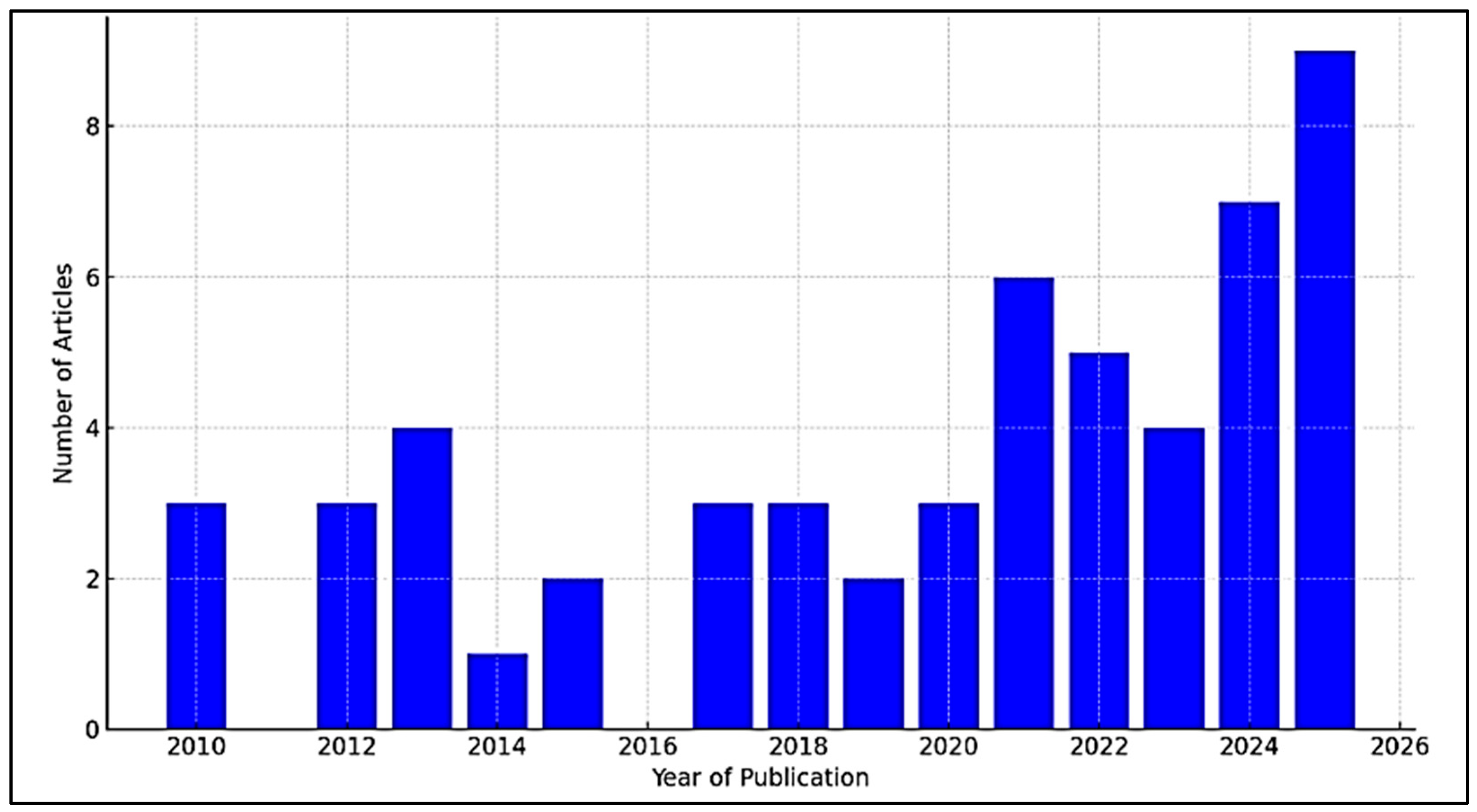


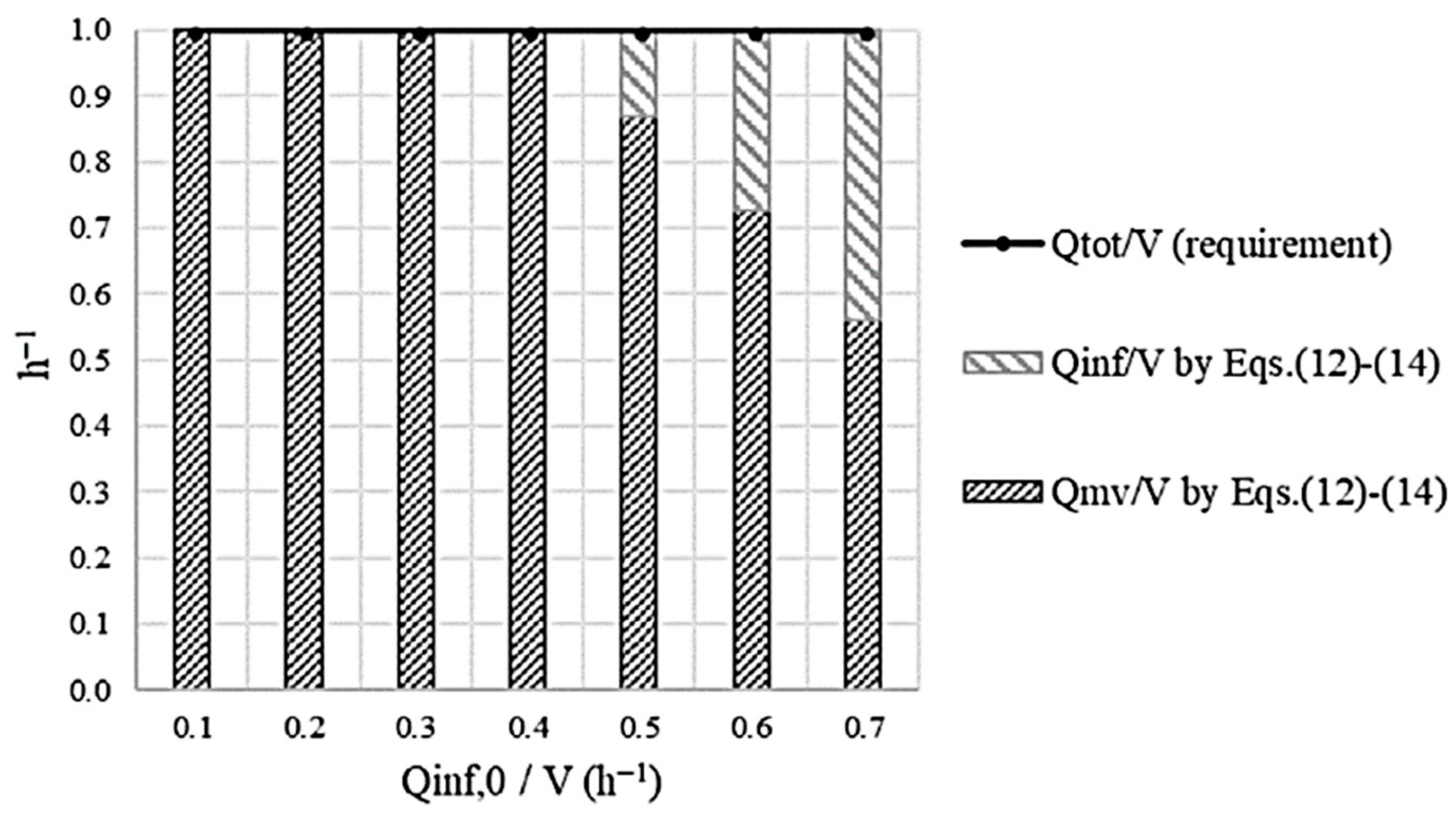
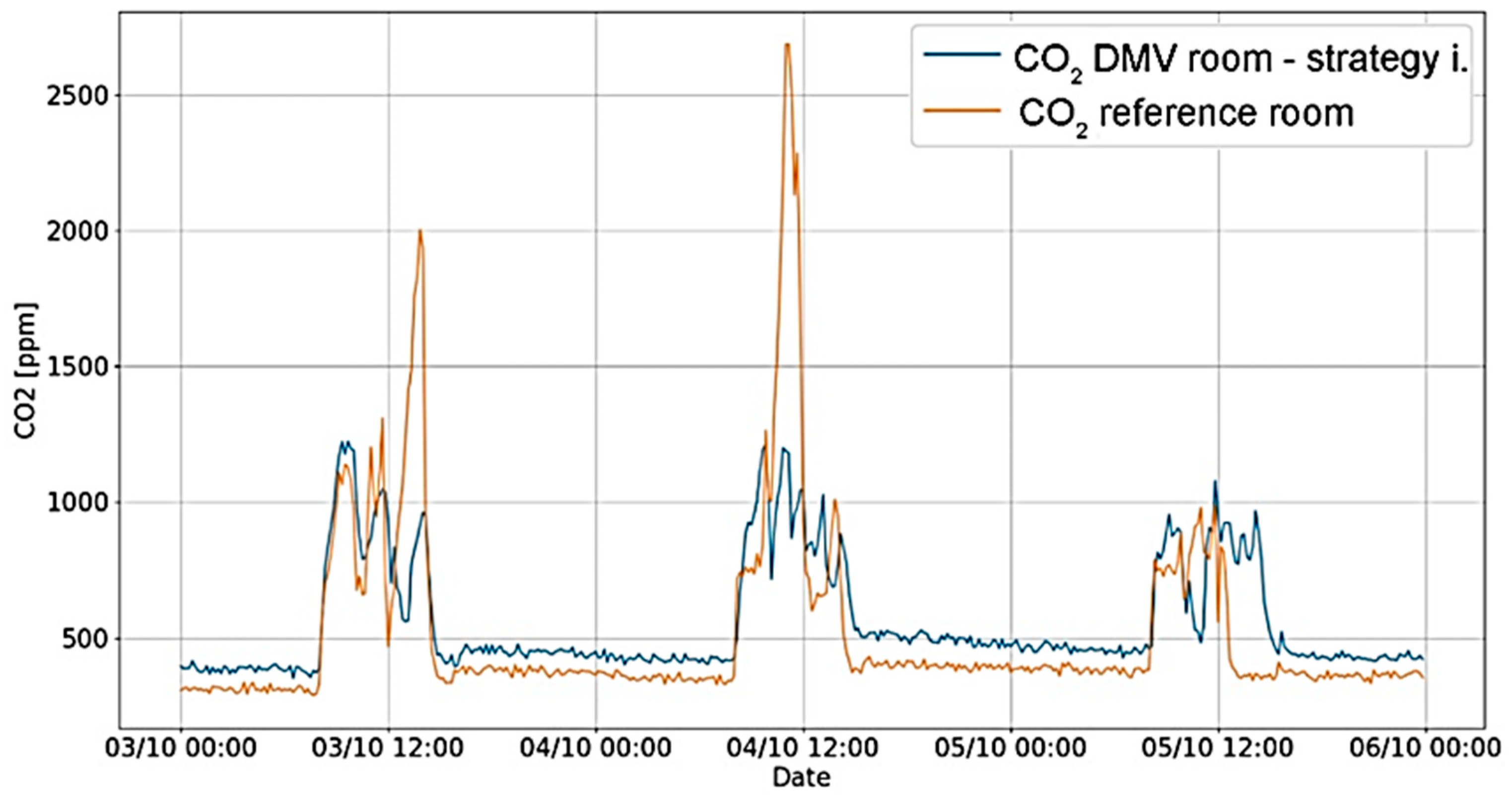

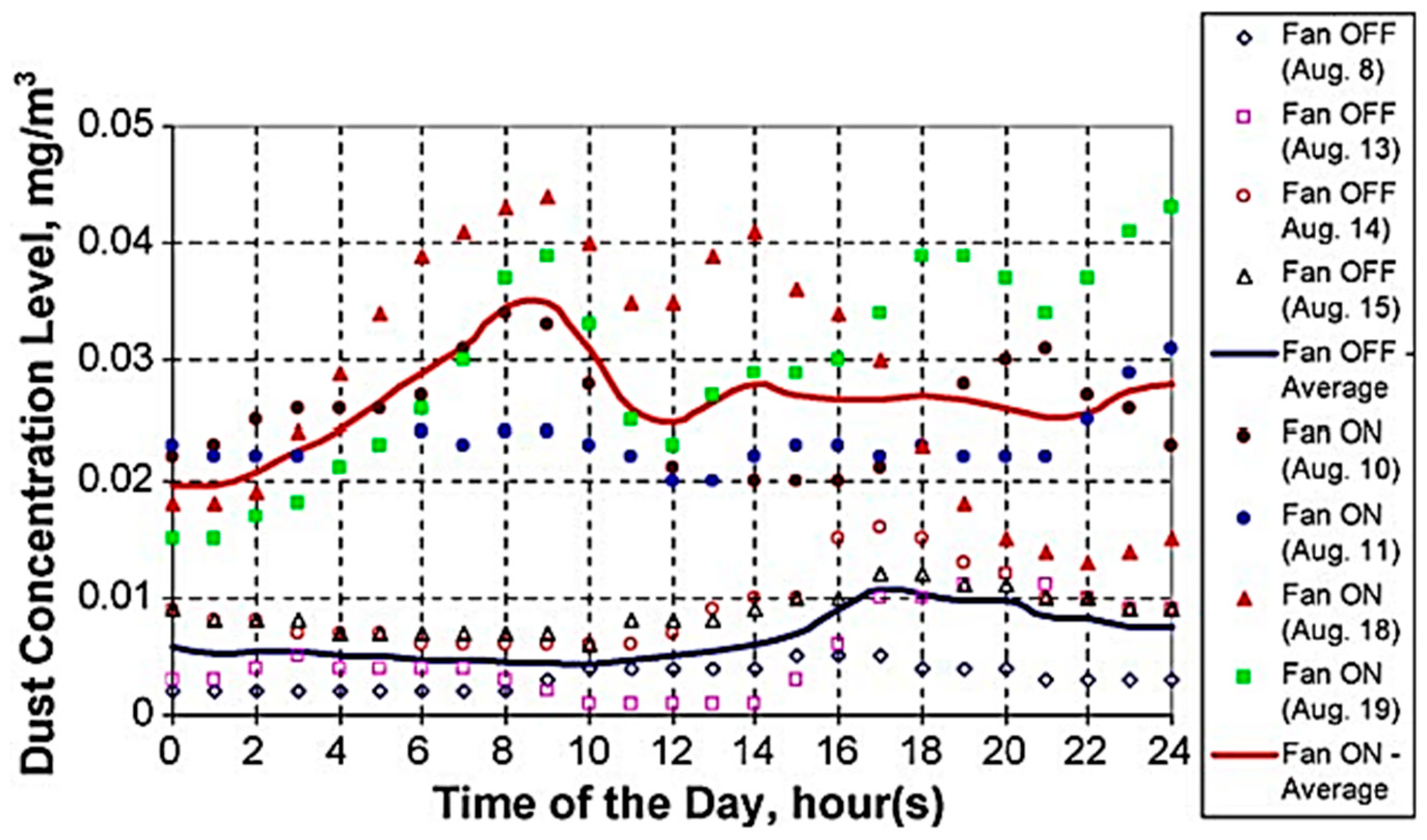
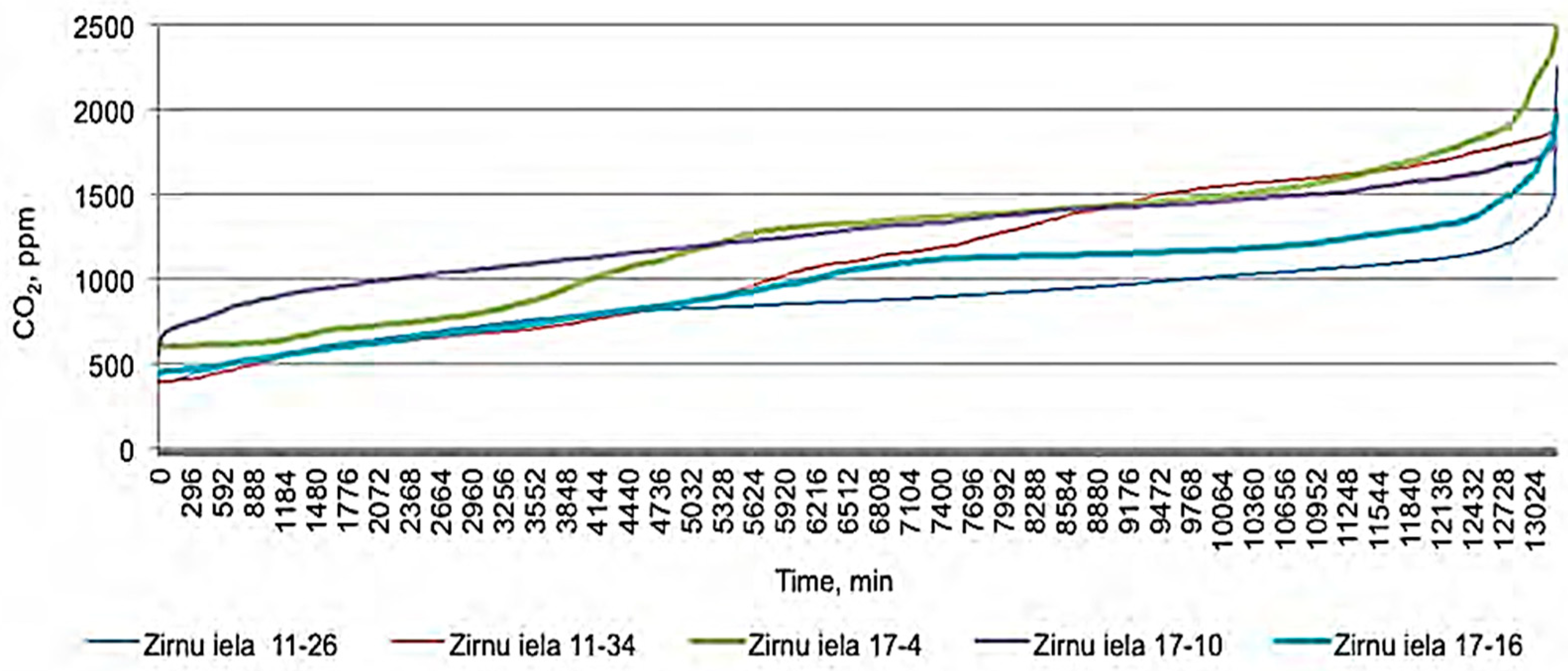
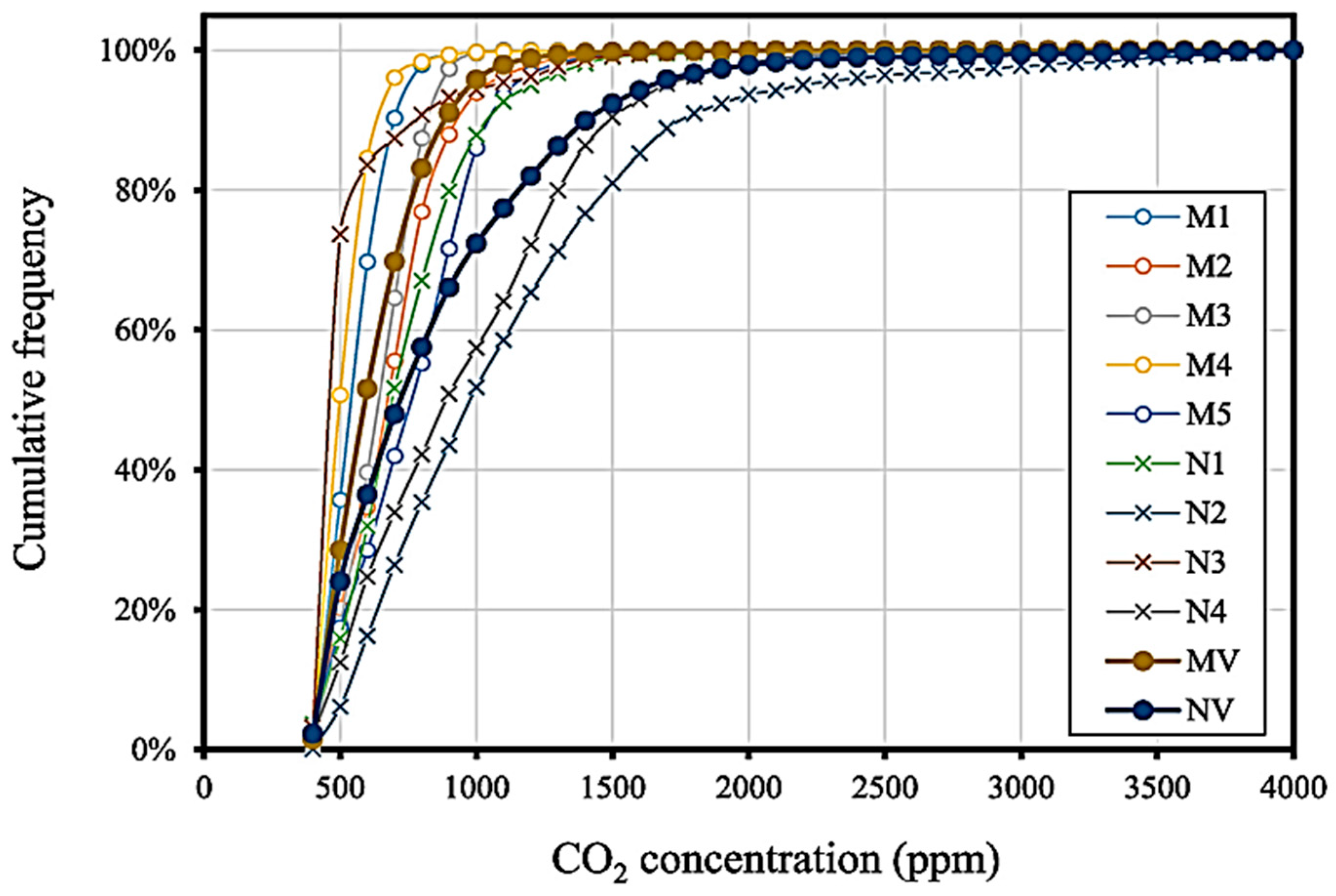
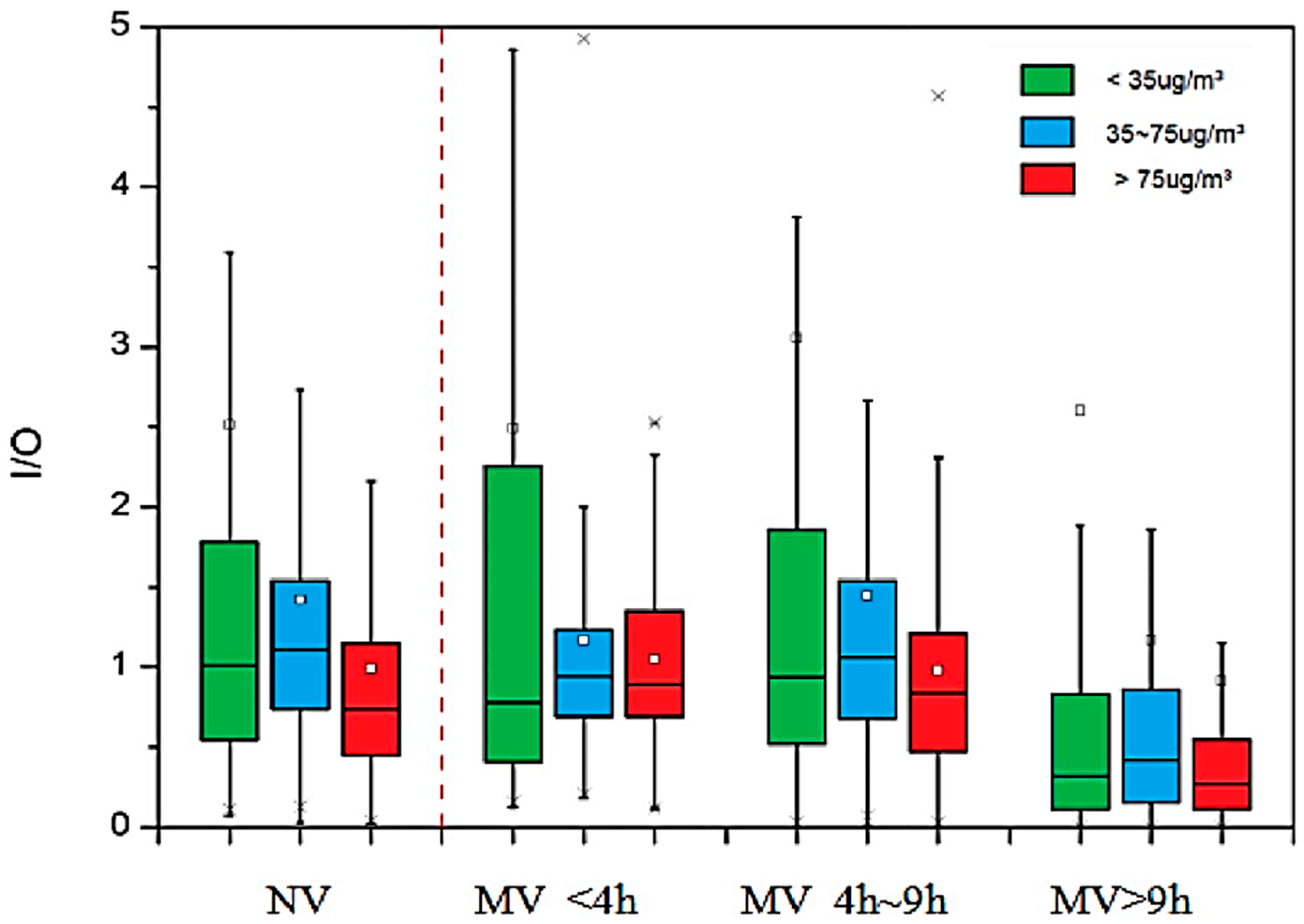

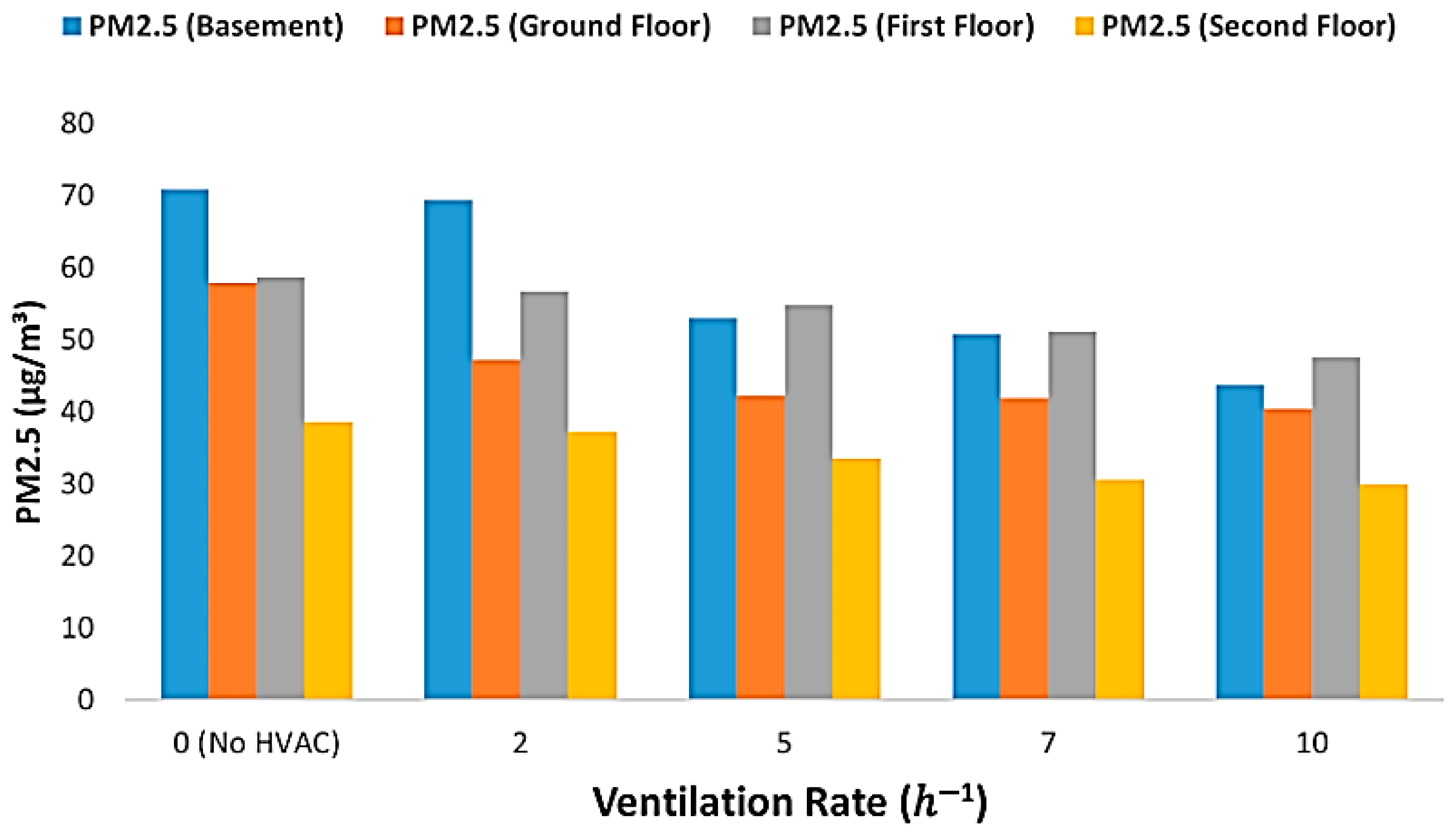


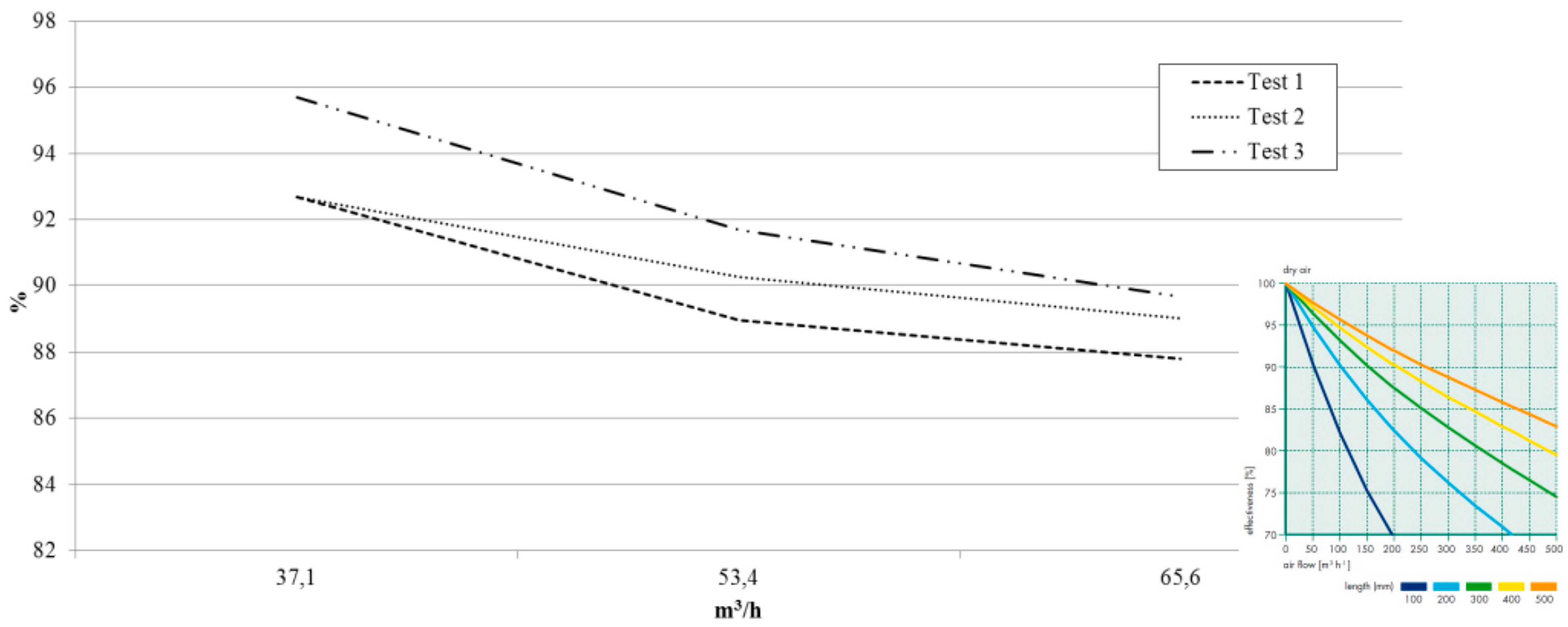




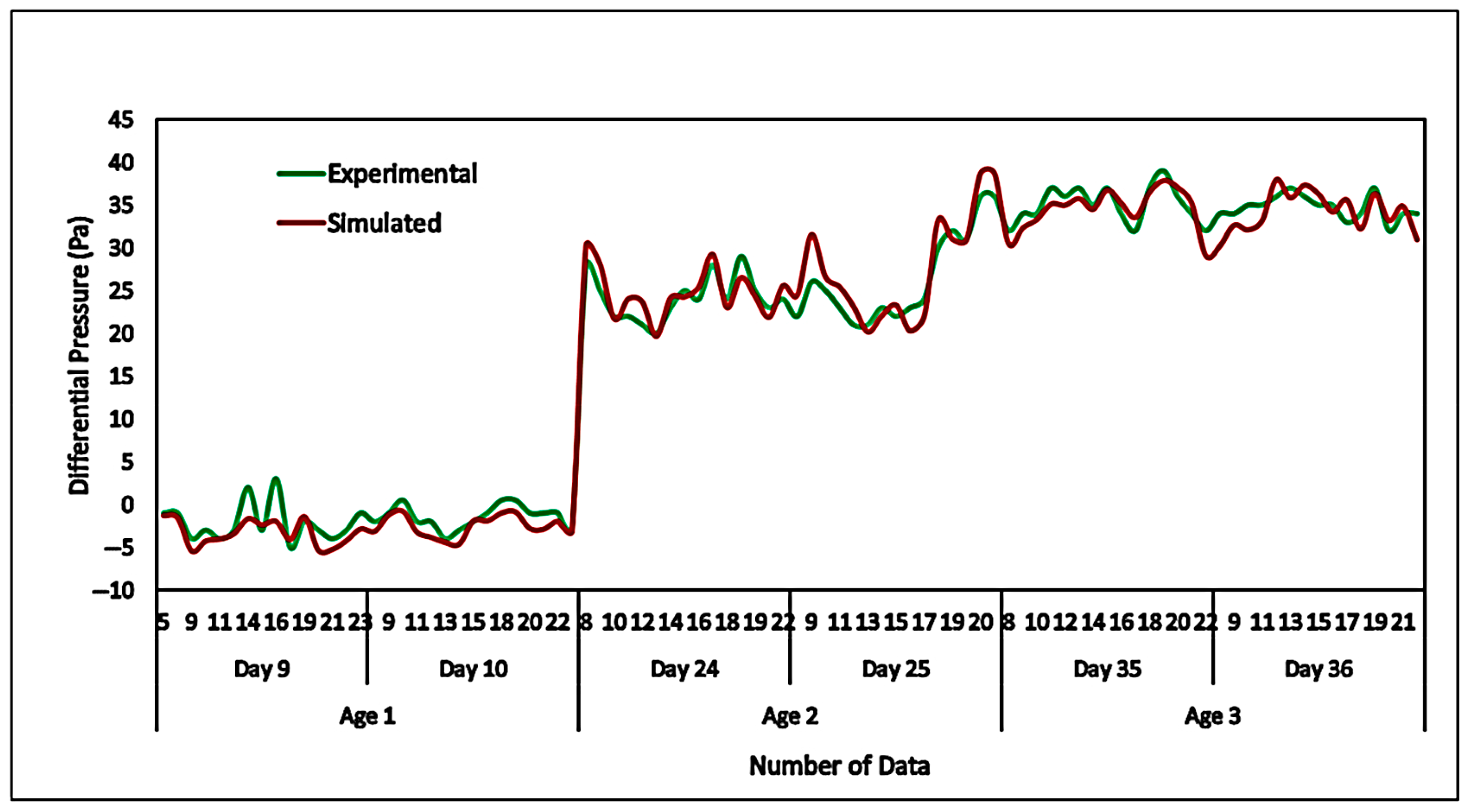
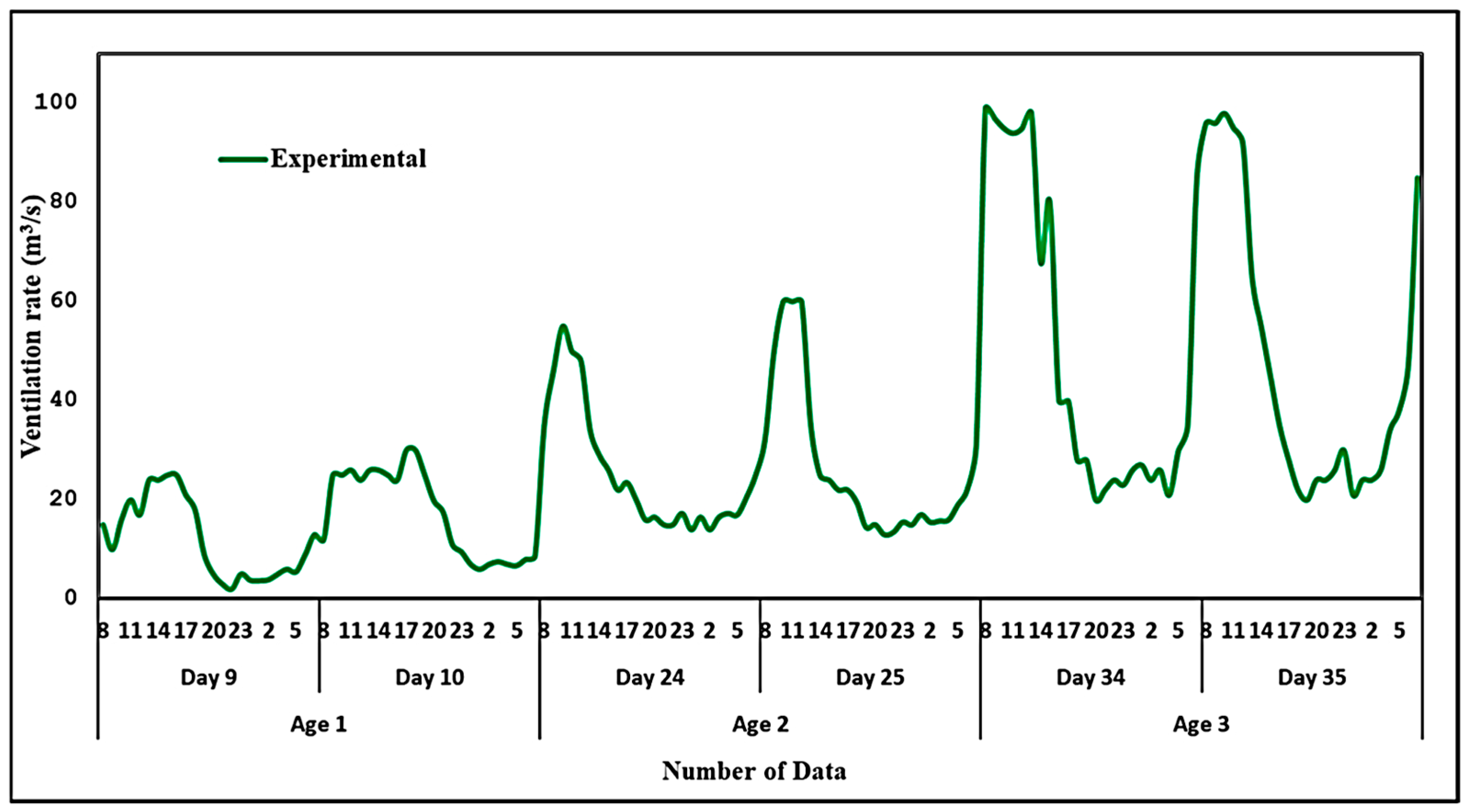
| Authors (Year) [Reference] | Modification | Key Performance Metrics | Results and Remarks |
|---|---|---|---|
| Calvet et al. (2010) [26] | Ventilation rate measurement system for poultry farms | Ventilation rate, measurement uncertainty | System accurately measured hourly ventilation rates with uncertainties <10%. Higher uncertainty (19.1%) when fewer fans were measured. |
| Lu et al. (2010) [27] | Novel method for estimating ventilation rates and CO2 generation | CO2 concentration, air change rate | Maximum Likelihood Estimation achieved high accuracy (R2 ≥ 0.998) in determining air change rates. |
| Turner et al. (2013) [28] | Health and energy impacts of ventilation commissioning | Health benefits (DALY), energy savings | Health benefits outweigh energy savings. Optimal ventilation rates balanced IAQ and energy use. |
| Shi and Li (2018) [31] | Infiltration rate vs. mechanical ventilation rate | ACH | Mechanical ventilation reduced infiltration rates by 15–45% when initial infiltration was >0.5 h−1. |
| Shi and Li (2020) [32] | Stack effect in buildings with multilayer windows | Infiltration rate, mechanical ventilation rate | Minimum mechanical ventilation rate to eliminate infiltration depends on window geometry (width-height ratio, spacing). |
| Zhang et al. (2021) [33] | DCV optimisation | Energy efficiency, IAQ, durability | Optimised DCV improved energy efficiency by 88% while maintaining IAQ and reducing on-off cycles. |
| Shin et al. (2023) [34] | Optimal ventilation control for livestock housing | Energy-saving performance (ESP) | Weather-based control strategy improved ESP by 20.5% over conventional methods. |
| Chiesa and Vigliotti (2024) [35] | Remote-control strategies for school ventilation | CO2 concentration, energy use | Threshold-based controls outperformed time-based ones. CO2 levels stayed below 800 ppm, with limited energy savings. |
| Rizzo et al. (2024) [36] | DCV in schools | CO2 levels, energy loss | DCV maintained CO2 <1000 ppm for 76% of the year. Natural ventilation caused excessive energy loss. |
| Liu et al. (2025) [37] | Occupant-centric ventilation control | PMV, CO2, energy savings | Strategy saved 18–51% energy by adjusting vents based on occupancy. Larger occupancy differences increased savings. |
| Authors (Year) [Reference] | Modification | Key Performance Metrics | Results and Remarks |
|---|---|---|---|
| Paul et al. (2010) [38] | Mechanically induced ventilation in Tuskegee Healthy House | IAQ, RH, dust concentration | Outdoor RH higher than indoor RH. Mechanical ventilation reduced dust concentration and improved IAQ. |
| Yu et al. (2014) [39] | CAV vs. VAV systems in polluted outdoor conditions | CO2 and particle concentrations | VAV systems increased particle concentrations in polluted outdoor air. CAV maintained stable CO2 levels but compromised particle control. |
| Kamendere et al. (2015) [40] | Mechanical ventilation with heat recovery in renovated buildings | CO2 concentration, energy efficiency | Heat recovery systems improved IAQ, but CO2 levels often exceeded 1000 ppm (68% of time in one building). |
| Lai et al. (2018) [21] | Natural vs. mechanical ventilation in Chinese apartments | Ventilation duration, climate impact | Natural ventilation usage increased in warmer climates/seasons. Occupants prioritized thermal comfort over IAQ. |
| Zhao et al. (2018) [41] | Mechanical vs. natural ventilation in cold climates | CO2 concentration, thermal comfort | Mechanical ventilation reduced CO2 levels but lowered indoor temperature (1.6 K) and humidity (3%). NV bedrooms had higher CO2 (>1000 ppm 28% of time). |
| Zhao and Liu (2020) [42] | Ventilation practices in Chinese apartments | ACH, PM2.5 filtration | Average ACH was 0.56 (50% efficiency). Occupants operated systems longer in winter due to higher outdoor PM2.5. |
| Lim et al. (2021) [43] | IAQ in EEH vs. conventional | PM, CO2, VOCs, health symptoms | EEH had lower pollutant levels. Higher CO2 correlated with eye fatigue and allergic symptoms. |
| Antonopoulos et al. (2023) [44] | WHMV in U.S. homes | ACH, occupant satisfaction | WHMV improved ACH by 0.18 h−1 on average; 35/46 occupants lacked operational knowledge. Dryness was a reported issue in cold climates. |
| Anyaegbuna et al. (2024) [46] | IAQ in bank vaults with mechanical ventilation | Radon, CO2, PM2.5 concentrations | Ventilation at 4.7 ACH kept pollutants below guidelines. CFD and CONTAM simulations agreed with measurements. |
| Summa et al. (2024) [47] | CMV in Italian classrooms | CO2 concentration, occupant behaviour | CMV effective in winter but windows opened in mid-season/summer. User errors led to CO2 exceedances. |
| Du et al. (2025) [48] | IAQ in Swiss primary schools | CO2, PM2.5, VOCs | Mechanical ventilation reduced CO2 and VOCs by 20–30% against natural ventilation. COVID-19 measures increased window opening in winter 2022. |
| Berneiser et al. (2025) [49] | User satisfaction with mechanical ventilation | Perceived usefulness, cleanliness | User satisfaction linked to system understandability and cleanliness. Noise/energy efficiency were less critical. |
| Ballerini et al. (2025) [50] | MVHR in Italian school classrooms | CO2, radon, student well-being | MVHR reduced CO2 and improved student attention. Radon levels remained low (21 Bq/m3). |
| Authors (Year) [Reference] | Modification | Key Performance Metrics | Results and Remarks |
|---|---|---|---|
| Yassine et al. (2012) [51] | Numerical model for energy-efficient mechanical ventilation | Energy consumption, thermal comfort | Optimal wall configuration reduced energy use and discomfort hours. Hempcrete insulation improved performance. |
| Asdrubali et al. (2015) [52] | Experimental evaluation of heat recovery systems | Heat recovery efficiency | Polystyrene heat exchanger achieved ~90% efficiency. Efficiency increased with lower mass flow rates. |
| Evola et al. (2017) [53] | CMV in residential units | Energy consumption, installation costs | CMV reduced energy use and improved IAQ compared to natural ventilation. Hygro-adjustable systems were most efficient. |
| Cablé et al. (2019) [54] | Wood-burning stove + mechanical ventilation in insulated houses | Thermal comfort, energy savings | Combined system improved thermal comfort (up to 9.5 °C in bedrooms) and saved 19% energy. |
| Sha and Qi (2020) [57] | Energy-saving approaches for high-rise mechanical ventilation | Energy consumption, cooling efficiency | Optimal control, efficient fans, and higher flow rates saved energy. Increasing flow rates beyond optimal had diminishing returns. |
| Sha et al. (2021) [58] | Ventilation control in high-rise buildings | Ventilation rate, energy savings | Optimal settings reduced energy use by 40% while maintaining low transmission risk. Required ventilation rates varied with protective measures. |
| Mechouet et al. (2021) [59] | PCM-enhanced walls with mechanical ventilation | Thermal comfort, energy savings | Mechanical ventilation improved PCM performance, reducing cooling energy use and payback periods. |
| Korpela et al. (2022) [60] | Waste heat recovery from exhaust air in Finland | Energy potential, CO2 reduction | Exhaust air heat pumps could save 18.7–36.8 GWh/year, reducing CO2 emissions by 590–944 t/year. Payback: 7–13 years. |
| Fix et al. (2022) [61] | Membrane-based HVAC system (AMX-R) | Cooling/dehumidification savings, ventilation rates | AMX-R saved 50% energy in humid climates and tripled ventilation rates at similar energy use. |
| Guan et al. (2023) [62] | Solar-air heating for mechanical ventilation preheating | Heat release efficiency, energy savings | System achieved 52–74% heat release efficiency. Preheated air for 5 h, reducing electric heating use by 6–8 kWh/day. |
| Miracco et al. (2025) [63] | Smart CMV control for university classrooms | CO2 levels, energy savings | CO2-based control with heat recovery saved 25% energy while maintaining IAQ. Underground classrooms benefited most. |
| Moghadam et al. (2025) [64] | Solar collector + MVHR in classrooms | Thermal performance, energy savings | TSC performance depended on wind and flow rate. System maintained comfort but increased fan energy use. |
| Authors (Year) [Reference] | Modification | Key Performance Metrics | Results and Remarks |
|---|---|---|---|
| Chiang et al. (2012) [65] | CFD study of radiant cooling with mechanical ventilation | Thermal comfort (PMV index) | Proper diffuser positioning improved thermal comfort. CFD validated experimental results. |
| Tomasi et al. (2013) [66] | Low ventilation rates in radiant floor systems | Thermal comfort, ventilation effectiveness | Acceptable thermal comfort was achieved, but floor cooling with unconditioned air caused temperature stratification. Ventilation effectiveness varied with supply/extract positions. |
| Wu et al. (2017) [67] | Hybrid radiant heating/ventilation systems | PMV-PPD, vertical temperature difference | DV caused larger temperature gradients (>3 °C) than mixing ventilation. All systems maintained PPD <10%. |
| Feng et al. (2019) [68] | Robotic contaminant source localization | Success rate, steps to locate source | The CPSO method achieved 93–100% success rates, outperforming SPSO (20%) and WUII (40%). |
| Rimdžius et al. (2021) [69] | Wind-energy-storage ventilation system | System functionality, energy efficiency | The Turbofan system increased ventilation functionality by 12–25% using renewable wind energy. |
| He et al. (2022) [70] | Roof window + mechanical ventilation in Active House | Air exchange rate, ventilation efficiency | Roof window ventilation was 1.62× more efficient than mechanical ventilation. Design and climate influenced performance. |
| Kalmár et al. (2022) [71] | Local ventilation effectiveness in small offices | CO2 concentration, air distribution | Personalized ventilation had the highest effectiveness (1.6–2.7) in screened desks. DV performed poorly (0.6–1.4). |
| Elghardouf et al. (2023) [72] | Differential pressure and air velocity in poultry houses | Pressure, air velocity | Pressure ranged from −5 to 39 Pa. Air velocity varied by regulation mode (0.09–1.64 m/s). Model validated experimental data. |
| Lin et al. (2024) [73] | Fire smoke dynamics under mechanical ventilation | Temperature distribution, heat transfer | Mechanical ventilation created “mutation points” in temperature gradients. Heat transfer coefficient correlated with ventilation rate and fire size. |
| Bai et al. (2025) [74] | Mechanical ventilation in high-humidity industrial buildings | Condensation, thermal comfort | Three stages identified: “Warm-Fog” (ACH = 0), “Cold-Fog” (ACH = 5–15), and “Cold-Dry” (ACH > 15). High ACH raised condensation above occupied zones but reduced comfort. |
| Riccardi et al. (2025) [75] | Radiant asymmetry with mechanical ventilation | Localized discomfort, PMV | Warm upper body and cold lower extremities reported. Balanced air/radiant temperatures minimize discomfort. |
| Authors (Year) [Reference] | Modification | Key Performance Metrics | Results and Remarks |
|---|---|---|---|
| Park and Kim (2012) [76] | Field study on ventilation practices in apartments | Heating energy consumption, occupant behaviour | A total of 68.3% of occupants avoided mechanical ventilation due to energy costs. Intermittent use improved IAQ but increased energy use by 32%. |
| Laverge et al. (2013) [77] | Multi-zone simulation of residential exhaust ventilation | IAQ, heat loss | Belgian, Dutch, and French standards achieved better IAQ than British and ASHRAE standards. Pareto optimal performance varied by standard. |
| Juraeva et al. (2013) [78] | Subway tunnel ventilation optimisation | Mass flow rate, airflow distribution | Top-wall-connected ventilation shafts outperformed side-wall shafts. Guide vanes improved airflow. |
| Bustamante et al. (2017) [79] | CFD and sensor validation for broiler house ventilation | Air velocity, thermal stress | CFD predicted heterogeneous air velocities (0.52–1.29 m/s). Insufficient airflow for bird thermoregulation. |
| Li et al. (2021) [80] | Fire pressure dynamics in ventilated compartments | Pressure amplitude, ventilation resistance | Pressure variations depended on ventilation resistances. Fire-induced pressure influenced flow rates but not gas temperatures. |
| Shum and Zhong (2022) [81] | Wildfire-resilient ventilation in Canadian homes | PM2.5 filtration, cost-benefit | Upgrading filters to MERV11–13 and increasing recirculation reduced indoor PM2.5 during wildfires. |
| Torresin et al. (2024) [82] | Window vs. mechanical ventilation in UK homes | Occupant behaviour, IAQ drivers | Window opening driven by IAQ/thermal comfort; closure by noise. Mechanical ventilation usage was low (6/61 homes). |
| Zhu et al. (2024) [83] | Novel MBCS | Smoke extraction efficiency | MBCS improved smoke extraction by 19.8% and heat extraction by 75.7% over traditional shafts. Efficiency increased with higher extraction velocity. |
Disclaimer/Publisher’s Note: The statements, opinions and data contained in all publications are solely those of the individual author(s) and contributor(s) and not of MDPI and/or the editor(s). MDPI and/or the editor(s) disclaim responsibility for any injury to people or property resulting from any ideas, methods, instructions or products referred to in the content. |
© 2025 by the authors. Licensee MDPI, Basel, Switzerland. This article is an open access article distributed under the terms and conditions of the Creative Commons Attribution (CC BY) license (https://creativecommons.org/licenses/by/4.0/).
Share and Cite
Rashid, F.L.; Al-Obaidi, M.A.; Al Maimuri, N.M.L.; Ameen, A.; Agyekum, E.B.; Chibani, A.; Kezzar, M. Mechanical Ventilation Strategies in Buildings: A Comprehensive Review of Climate Management, Indoor Air Quality, and Energy Efficiency. Buildings 2025, 15, 2579. https://doi.org/10.3390/buildings15142579
Rashid FL, Al-Obaidi MA, Al Maimuri NML, Ameen A, Agyekum EB, Chibani A, Kezzar M. Mechanical Ventilation Strategies in Buildings: A Comprehensive Review of Climate Management, Indoor Air Quality, and Energy Efficiency. Buildings. 2025; 15(14):2579. https://doi.org/10.3390/buildings15142579
Chicago/Turabian StyleRashid, Farhan Lafta, Mudhar A. Al-Obaidi, Najah M. L. Al Maimuri, Arman Ameen, Ephraim Bonah Agyekum, Atef Chibani, and Mohamed Kezzar. 2025. "Mechanical Ventilation Strategies in Buildings: A Comprehensive Review of Climate Management, Indoor Air Quality, and Energy Efficiency" Buildings 15, no. 14: 2579. https://doi.org/10.3390/buildings15142579
APA StyleRashid, F. L., Al-Obaidi, M. A., Al Maimuri, N. M. L., Ameen, A., Agyekum, E. B., Chibani, A., & Kezzar, M. (2025). Mechanical Ventilation Strategies in Buildings: A Comprehensive Review of Climate Management, Indoor Air Quality, and Energy Efficiency. Buildings, 15(14), 2579. https://doi.org/10.3390/buildings15142579











